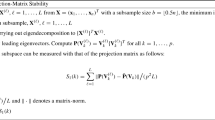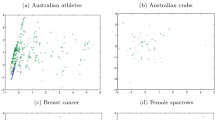Abstract
This study investigates’ Projection Spectral Analysis’, which generalizes’ Principal or Independent Component Analysis’ by dealing with a non-symmetric square correlation or covariance matrix with multiplicities or singularities. This type of covariance matrix is decomposed into projections and nilpotents according to the spectral theorem. Projection spectral analysis solves a learning problem by reducing the dimension for multiple zero eigenvalues, and may be applied to a non-symmetric covariance with distinct eigenvalues. This method involves a sum-product of orthogonal projection operators and real distinct eigenvalues for a symmetric covariance, which makes it equivalent to principal component analysis. However, it becomes independent component analysis if the covariance is not symmetric.
Similar content being viewed by others
References
A. W. Naylor and G. R. Sell, Linear Operator Theory in Engineering and Science -Applied Mathematical Sciences, Springer-Verlag, Inc., New York, vol. 40, 1982.
D. Hebb, Organization of Behavior, Science Edition, Inc., New York, 1961.
J. J. Hopfield, “Neural networks and physical systems with emergent collective computational abilities,” Proc. National Academic Sciences USA, Biophysics, vol. 79, pp. 2554–2558, April 1982.
B. Kosko, “Bidirectional associative memories,” IEEE Trans. Syst., Man, Cybern., vol. 18, no. 1, pp. 49–60, January/February 1988.
M. Turk and A. Pentland, “Eigenfaces for recognition,” Journal of Cognitive Neuroscience, vol. 3, no. 1, pp. 71–86, 1991.
A. H. Hyvärinen, J. Karhunen, and E. Oja, Independent Component Analysis, John Wiley and Sons, Inc., New York, 2001.
J. V. Stone, Independent Component Analysis - A Tutorial Introduction, The MIT Press, Cambridge, MA, 2004.
H. Kang, “Multilayered associative neural networks (m. a. n. n.): storage capacity vs. perfect recall,” IEEE Trans. Neural Netw., vol. 5, no. 5, pp. 812–822, September 1994.
H. Kang, “Multilayer associative neural networks (m. a. n. n.): storage capacity vs. noise-free recall,” in Neural Network Theory, Technology, and Applications, ser. IEEE Technology Update Series, P. K. Simpson, Ed. IEEE, 1996, pp. 215–221.
G. E. Hinton, S. Osindero, and Y. W. Teh, “A fast learning algorithm for deep belief nets,” Neural Computation, vol. 18, no. 7, pp. 1527–1554, 2006.
Y. Bengio, “Learning deep architecture for AI,” Foundations and Trends in Machine Learning, vol. 2, no. 1, pp. 1–127, 2009.
H. Kang, “Unsupervised learning with associative cubes for robust gray-scale image recognition,” Proc. ICNN&B 05, pp. 1864–1869, Beijing China, October 2005.
H. Kang, “Associative cubes in unsupervised learning for robust gray-scale image recognition,” Proc. 3rd Int. Symposium on Neural Networks, Advances in Neural Networks, Springer-Verlag, Berlin Heidelberg, J.W. et al., ed., vol. LNCS 3972, pp. 581–588, 2006.
C.-T. Chen, Linear System Theory and Design, Oxford University Press, Inc., New York, 1999.
Author information
Authors and Affiliations
Corresponding author
Additional information
Recommended by Associate Editor DaeEun Kim under the direction of Editor Myotaeg Lim.
This work was supported by a grant from the National Research Foundation of Korea (NRF), funded by the Korean Government (MSIP) (No. NRF-2011-0015976), and by the Chung-Ang University Research Scholarship Grants in 2014.
Hoon Kang was born in Seoul, Korea, in 1959. He received his B.S. and M.S. degrees in Electronic Engineering from the Seoul National University, Korea, in 1982 and 1984, respectively. He earned his Ph.D. degree and the CIMS certificate in the School of Electrical Engineering at the Georgia Institute of Technology, Atlanta, in 1989. From 1989 to 1991, he was first a postdoctoral fellow and then a research associate in the Georgia Tech Electrical Engineering Department. As he participated in a number of projects sponsored by the national science foundation, the office of naval research, the ford motor company, and honeywell inc., he developed new research ideas on fuzzy logic control, intelligent robotic control, and fault detection and identification. He also joined a NASA SBIR project on active damping control of the remote manipulator systems when he worked for automation concepts and systems, inc., as a research engineer in 1991. Since 1992, He joined the School of Electrical and Electronics Engineering at Chung-Ang University, Seoul, Korea. He has served as the department chair, the financial secretary both for the Korean Intelligent Information Systems (KIIS) and for the Institute of Control, Robotics and Systems (ICROS). He also joined the Institute of Electronics Engineers of Korea (IEEK) as a financial secretary, an editorial board member, and a general affairs director. His research interests include computational intelligence such as fuzzy systems, neural networks, evolutionary computation, artificial life; robotics and robot vision such as visual tracking, object recognition, human computer interfaces, intelligent robots, and humanoids.
Joonsoo Ha received his B.S. degree from the School of Electrical and Electronics Engineering, Chung-Ang University, Seoul, Korea, in 2013. He is currently working toward an M.S. degree in intelligent robot at Chung-Ang University. Now, he joined Intelligent robot and vision lab, working on high-performance smart vision interface (SVI) and emergent artificial life forms. His research interests include robotics, image processing, fuzzy systems and neural networks.
Rights and permissions
About this article
Cite this article
Kang, H., Ha, J. Projection spectral analysis. Int. J. Control Autom. Syst. 13, 1530–1537 (2015). https://doi.org/10.1007/s12555-014-0286-y
Received:
Revised:
Accepted:
Published:
Issue Date:
DOI: https://doi.org/10.1007/s12555-014-0286-y




